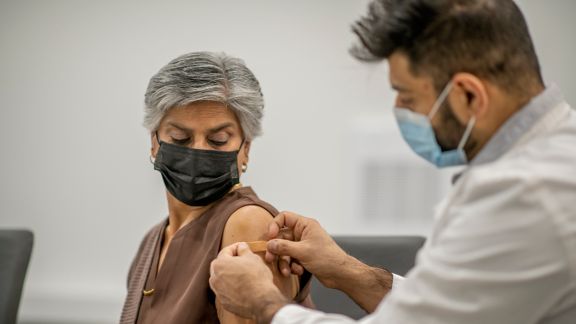The Resilience of LGBTQ+ Youth Experiencing Technology-Facilitated Abuse

Authors
Senior Research Scientist
April 2024
Recently, NORC’s Cyber-Abuse Research Initiative (CARI) team conducted a study on how technology-facilitated abuse affects the lives of young people in the United States.
Technology-facilitated abuse, or TFA for short, refers to the “misuse of technology to harm, harass, threaten, coerce, exploit, or violate a person” through actions like cyberbullying, cyber harassment, or cyberstalking.
The CARI study is among the first nationally representative samples of young adults (age 18-35) to examine TFA and its effects. A sizeable portion (18 percent) of the CARI sample identified as LGBTQ+, which provided the team with a unique opportunity to explore the extent to which LGBTQ+ young adults experience online abuse.
NORC examined the prevalence and severity of technology-facilitated abuse against LGBTQ+ young people.
The CARI team undertook two sets of analyses focused on LGBTQ+ young adults. The first set of analyses, led by Stefan Vogler, investigated the prevalence and perpetrators of TFA against LGBTQ+ young adults. The team found that LGBTQ+ young adults reported a higher prevalence of TFA than their cisgender, heterosexual peers (81 percent versus 68 percent) and that a greater proportion of LGBTQ+ young adults reported TFA perpetrated by either family or an intimate partner/ex-intimate partner than the proportion of heterosexual participants who experienced TFA from these close connections.
The second set of analyses, currently under publication review, examined the severity of TFA victimization by sexual identity among young adults in the CARI sample. These analyses revealed that, compared to heterosexual young adults, sexual minority (i.e., lesbian, gay, bisexual, or other non-heterosexual) young adults were more likely to endure multiple forms of TFA. Across a list of 27 different TFA activities (see callout box for examples), sexual minority young adults reported, on average, six different TFA experiences. In contrast, heterosexual young adults reported an average of four experiences. Furthermore, sexual minority young adults were more likely to report that their TFA escalated into in-person abuse or physical harm than heterosexual young adults.
Our findings aligned with other national data on violence against LGBTQ+ people.
Given what we know about LGBTQ+ communities, harassment, and violence broadly, these CARI findings are unsurprising, albeit disheartening. The results certainly align with what national data consistently tell us about violence against LGBTQ+ people:
- LGBTQ+ youth experience higher rates of bullying in schools.
- Lesbian and gay adults are twice as likely to experience violent victimization than straight individuals.
- Rates of aggravated assault against bisexual adults are significantly higher than straight adults.
- Transgender adults are more likely to experience physical and sexual assault than cisgender adults.
Learning that LGBTQ+ people experience a more hostile online landscape than their straight, cisgender peers certainly can be read as another disappointing data point in a broader story of how social stigma against LGBTQ+ communities manifests, yet that is not the whole story.
Solely focusing on victimization misses an important part of the story—resilience.
Resilience frameworks offer us another avenue for understanding data points like those from CARI. As a graduate student at the University of Michigan, I sat in on a guest lecture by Ron Stall, an early pioneer in LGBTQ+ health research, who presented the latest disparity data on LGBTQ+ populations. Across each statistic he shared, we saw yet another benchmark of how public health problems like violence, substance use, and depression disproportionately impacted LGBTQ+ populations. As the audience lurched toward despair, Dr. Stall asked, “What is the other side of the story? Where could we find evidence of the resilience of LGBTQ+ people?”
From there, a rich discussion emerged about how, for each outcome, despite LGBTQ+ folks carrying a greater burden, there remained those LGBTQ+ folks who were not affected at all. No violence. No substance use. No depression. Despite living in the same context, where social stigma against LGBTQ+ people can erode health and well-being through minority stress, every day LGBTQ+ people side-step the fatalistic narrative these statistics provide. When we, as researchers, practitioners, and humans invested in equity, focus solely on who experiences disparities and overlook who does not experience the disparity, we lose sight of the full story.
So, what is the full story with the CARI data?
Reflecting on how resilience relates to these findings about TFA and young people invites new avenues for future research. To begin, we might design new studies to investigate where and how LGBTQ+ young adults thrive online despite the near-ubiquitous levels of TFA among the LGBTQ+ young adults in this study. Direct investigation into positive online experiences is particularly critical given that prior research tells us that online communities offer essential sources of identity affirmation and support to many LGBTQ+ youth.
Situating ourselves in relationship to the full story also means asking important follow-up questions—namely, who is thriving? Or, more specifically, who are the 19 percent of LGBTQ+ youth who never experienced TFA? Emphasizing resilience can inspire us to look at within-group differences among LGBTQ+ young adults. For example, which groups of LGBTQ+ youth report the fewest experiences of TFA? What characteristics or experiences, whether social, interpersonal, or individual, do they have in common? How might these commonalities inform avenues through which online spaces could be improved?
Certainly, calls to embed resilience frameworks into LGBTQ+ research are not new. In fact, some scholars ask whether resilience is truly enough, given its assumption of overcoming adversity. Alternatively, a truly revolutionary and holistic goal might be fully eradicating oppression and marginalization from queer people’s lives. (See more on these topics from thought leaders and researchers Annaliese Singh and Delia Mosley.) Yet there is value in a renewed commitment to considering resilience in relationship to LGBTQ+ well-being, as the social obstacles toward thriving show no signs of abating.
In thinking about TFA and how it affects LGBTQ+ people, centering resilience orients us toward strategies for cultivating online spaces that are safe and welcoming for individuals of all identities. What we learn about the mechanism that protects one group of LGBTQ+ people from TFA can be the tool that gets used or scaled to improve the online safety of LGBTQ+ folks across the board. Resilience can lead toward prevention and may be an important tool for researchers and practitioners invested in moving LGBTQ+ closer toward equity.
Examples of TFA Experiences from the CARI Study
Surveillance
- “Used my computer, phone or other electronic device to get information about me or other people”
- “Checked my phone call histories without my permission”
Cyber-Interference/Communications
- “Sent me threatening, frightening, harassing or aggressive messages via email, text, social media, or another online platform”
- “Encouraged other people to “troll,” attack, or harass me online”
Reputational Harm
- “Distributed, or posted online, an intimate image of me without my consent”
- “Damaged, or tried to damage, my reputation by posting false, negative, or private information about me”
Monitoring/Tracking
- “Monitored or spied on me using spyware/stalkerware”
- “Monitored or spied on me using cameras, drones or a ‘bugging’ or eavesdropping device”
Fraud
- “Used or attempted to use my personal information for some fraudulent purpose, including identity theft”
- “Attempted to deceive me into sending money or providing personal information about myself (sometimes called scamming, can include romance scams)”
Further Reading
Bower KL, Lewis DC, Bermudez JM, Singh AA. Narratives of Generativity and Resilience among LGBT Older Adults: Leaving Positive Legacies despite Social Stigma and Collective Trauma. Journal of Homosexuality. 2021;68(2).
Herrick AL, Lim SH, Wei C, et al. Resilience as an untapped resource in behavioral intervention design for gay men. AIDS Behav. 2011;15 Suppl 1:S25-9. doi:10.1007/s10461-011-9895-0
Hillier A, Kroehle K, Edwards H, Graves G. Risk, resilience, resistance and situated agency of trans high school students. Journal of LGBT Youth. 2019;17(4):384-407. doi:10.1080/19361653.2019.1668326
Johns MM, Poteat VP, Horn SS, Kosciw J. Strengthening Our Schools to Promote Resilience and Health Among LGBTQ Youth: Emerging Evidence and Research Priorities from The State of LGBTQ Youth Health and Wellbeing Symposium. LGBT Health. 2019;6(4):146-155. doi:10.1089/lgbt.2018.0109
Mosley DV, McNeil-Young V, Bridges B, et al. Toward radical healing: A qualitative metasynthesis exploring oppression and liberation among Black queer people. Psychology of Sexual Orientation and Gender Diversity. 2021;8(3):292-313. doi:10.1037/sgd0000522
Singh AA, Finan R, Estevez R. Queer and Trans Resilience: Moving from Affirmation to Liberation in Our Collective Healing. In: Koch JM, Townsend-Bell EE, Hubach RD, eds. Identity as Resilience in Minoritized Communities: Strengths-Based Approaches to Research and Practice. Emerging Issues in Family and Individual Resilience. Springer Nature Switzerland; 2023:1-22. doi:10.1007/978-3-031-38977-1_1
Citation
Johns, M. (April 2024). Technology-Facilitated Abuse, LGBTQ+ Youth, and the Value of Resilience Frameworks. NORC at the University of Chicago. Retrieved from https://www.norc.org.







